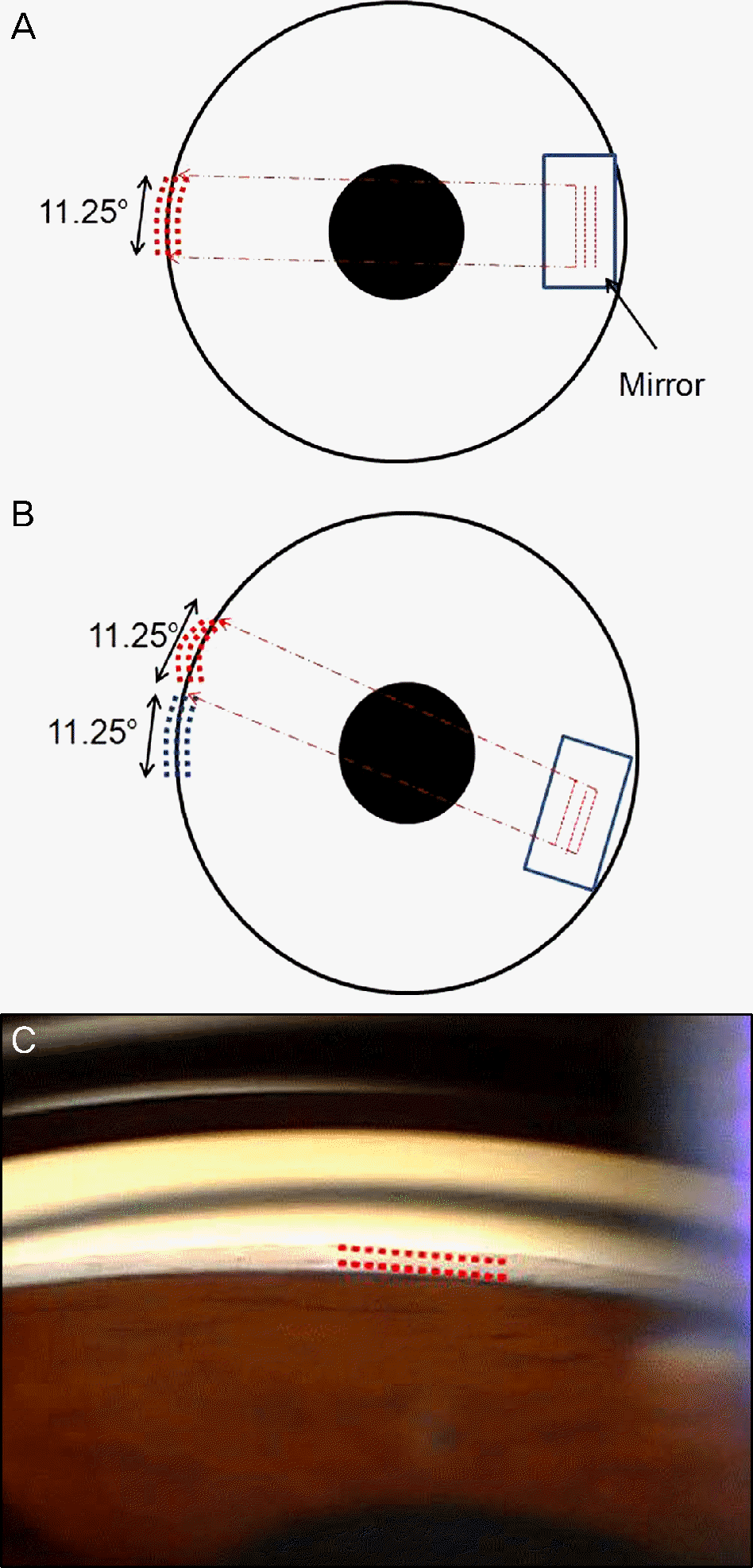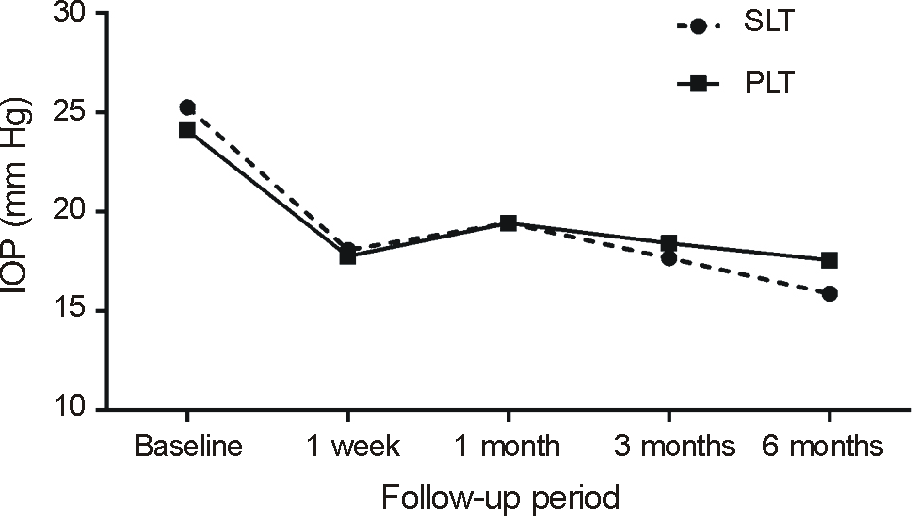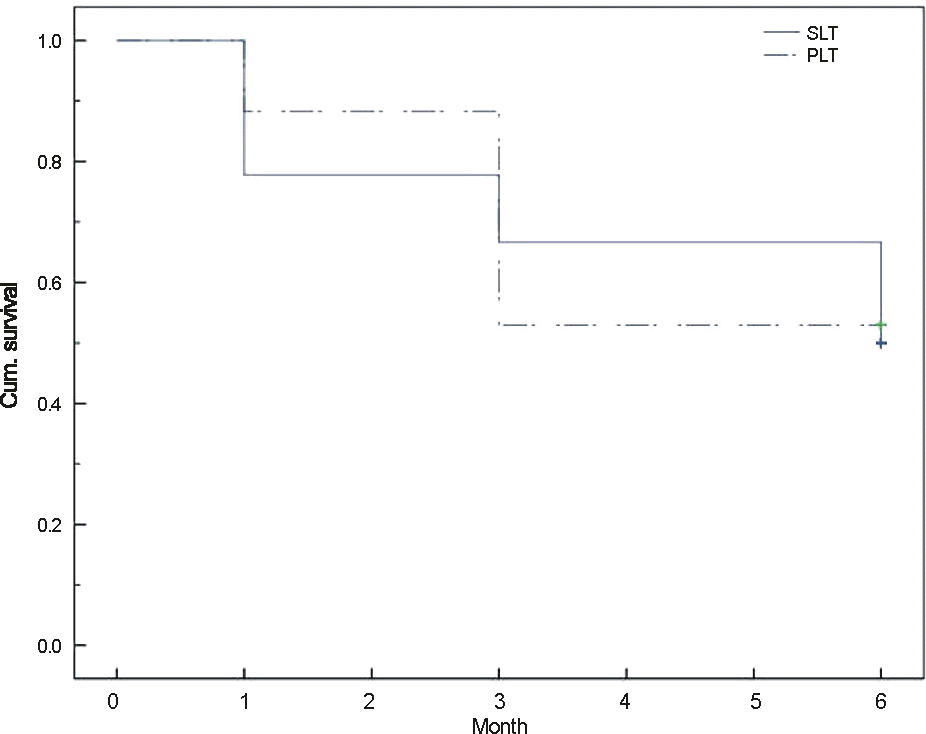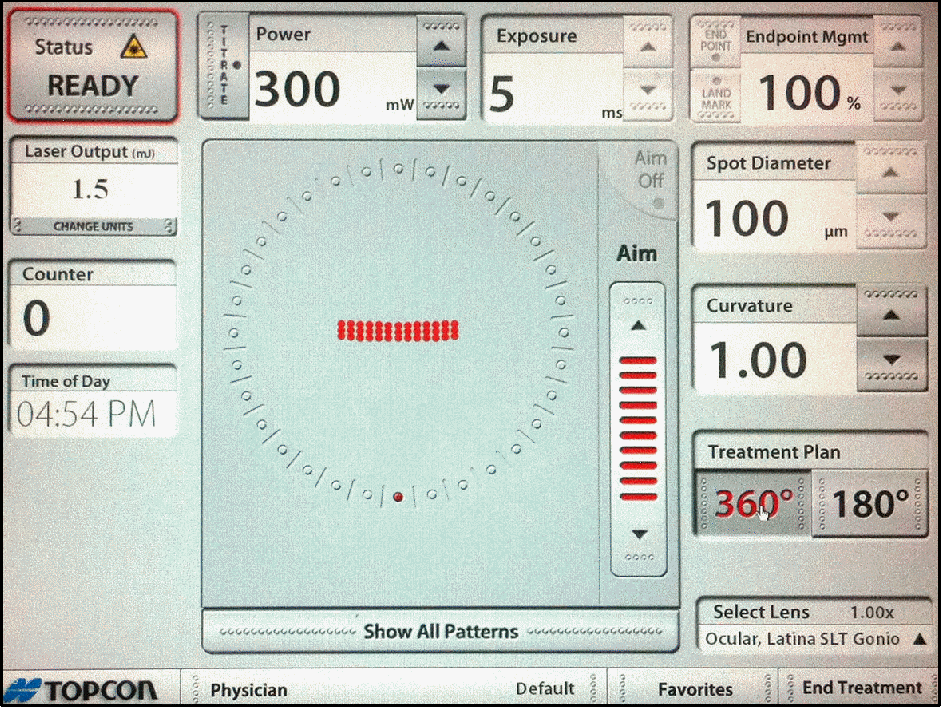Abstract
Purpose
To evaluate the pressure-lowering effects of single-spot laser trabeculoplasty and patterned laser trabeculoplasty using a 577-nm wavelength laser.
Methods
A total 35 eyes of 35 patients with primary open-angle glaucoma were enrolled in this study. Eighteen eyes of 18 patients were treated with 360° single-spot laser trabeculoplasty and 17 eyes of 17 patients were treated with 360° patterned laser trabeculoplasty. All patients were evaluated after laser trabeculoplasty at 1 week, 1 month, 3 months, and 6 months using slit lamp examination and Goldmann applanation tonometry.
References
1. Wise JB, Witter SL. Argon laser therapy for open-angle glaucoma. A pilot study. Arch Ophthalmol. 1979; 97:319–22.
2. Latina MA, Park C. Selective targeting of trabecular meshwork cells: in vitro studies of pulsed and CW laser interactions. Exp Eye Res. 1995; 60:359–71.

3. Cho BJ, Kim TW, Woo SJ, et al. Short-term clinical outcome of patterned scanning laser photocoagulation with short exposure time in diabetic retinopathy. J Korean Ophthalmol Soc. 2009; 50:376–82.

4. Turati M, Gil-Carrasco F, Morales A, et al. Patterned laser trabeculoplasty. Ophthalmic Surg Lasers Imaging. 2010; 41:538–45.

5. Hodapp E, Parrish RK II, Anderson DR. Clinical decisions in glaucoma. St. Louis: Mosby;1993. p. 52–61.
6. Wise JB. Glaucoma treatment by trabecular tightening with the argon laser. Int Ophthalmol Clin. 1981; 21:69–78.

7. Van Buskirk EM, Pond V, Rosenquist RC, Acott TS. Argon laser trabeculoplasty. Studies of mechanism of action. Ophthalmology. 1984; 91:1005–10.
8. Alvarado JA, Alvarado RG, Yeh RF, et al. A new insight into the cellular regulation of aqueous outflow: how trabecular meshwork endothelial cells drive a mechanism that regulates the permeability of Schlemm's canal endothelial cells. Br J Ophthalmol. 2005; 89:1500–5.

9. Bradley JM, Anderssohn AM, Colvis CM, et al. Mediation of laser trabeculoplasty-induced matrix metalloproteinase expression by IL-1beta and TNFalpha. Invest Ophthalmol Vis Sci. 2000; 41:422–30.
10. Samples JR, Singh K, Lin SC, et al. Laser trabeculoplasty for open-angle glaucoma: a report by the american academy of ophthalmology. Ophthalmology. 2011; 118:2296–302.
11. Worthen DM, Wickham MG. Laser trabeculotomy in monkeys. Invest Ophthalmol. 1973; 12:707–11.
12. Park JJ, LEE JW, Lee KW. Comparison of clinical outcomes of argon laser versus selective laser trabeculoplasty in POAG. J Korean Ophthalmol Soc. 2008; 49:1491–500.

13. Brancato R, Carassa R, Trabucchi G. Diode laser compared with argon laser for trabeculoplasty. Am J Ophthalmol. 1991; 112:50–5.

14. Chung PY, Schuman JS, Netland PA, et al. Five-year results of a randomized, prospective, clinical trial of diode vs argon laser trabeculoplasty for open-angle glaucoma. Am J Ophthalmol. 1998; 126:185–90.

15. Kramer TR, Noecker RJ. Comparison of the morphologic changes after selective laser trabeculoplasty and argon laser trabeculoplasty in human eye bank eyes. Ophthalmology. 2001; 108:773–9.

16. Allingham RR. Shields textbook of glaucoma. 6th ed.Wolters Kluwer: Lippincott Williams&Wlikins;2011. p. 455.
17. Jang YS, Kim JM, Lim TH, et al. Comparison of 180° and 360° selective laser trabeculoplasty. J Korean Ophthalmol Soc. 2012; 53:291–6.

18. Schuele G, Rumohr M, Huettmann G, Brinkmann R. RPE damage thresholds and mechanisms for laser exposure in the micro-second-to-milisecond time regimen. Invest Ophthalmol Vis Sci. 2005; 46:714–9.
Figure 2.
Procedure of patterned laser trabeculoplasty. (A) Schematic view of patterned laser trabeculoplasty. Pattern of Aiming beam (635 nm) is projected on trabecular meshwork. Once a physician presses the foot pedal, PASCAL photo-coagulator delivers a patterned laser on trabecular meshwork. (B) After shooting the laser, the pattern is automatically ro-tated clockwise by 11.25˚. (C) Gonioscopic view of patterned laser trabeculoplasty.

Figure 3.
Changes in mean intraocular pressure after laser trabeculoplasty. No statistical differences between the groups during follow-up (p > 0.05, Mann-Whitney test). SLT = single spot laser trabeculoplasty; PLT = patterned laser trabeculoplasty.

Figure 4.
Kaplan-Meier survival curve using success defi-nition in single spot laser trabeculoplasty and patterned laser trabeculoplasty groups. No statistical differences between the groups during follow-up (p = 0.93). Cum = cumulative; SLT = single spot laser trabeculoplasty; PLT = patterned laser trabeculoplasty.

Table 1.
Patient demographics
| Single spot laser group | Patterned laser group | p-value | |
|---|---|---|---|
| Age (years) | 53 ± 16.59 (19-72) | 46 ± 9.5 (35-65) | 0.30* |
| Sex : | 0.87† | ||
| Male | 10 | 8 | |
| Female | 8 | 9 | |
| Mean number of glaucoma medication (n, range) | 0.81 ± 1.17 (0-3) | 1.30 ± 1.25 (0-3) | 0.44* |
| Baseline IOP (mm Hg, range) | 25.27 ± 7.51 (18-32) | 24.11 ± 4.17 (19-45) | 0.91* |
| Mean duration of increased IOP (month) | 2.44 ± 1.69 (1-5) | 2.35 ± 1.59 (1-6) | 0.64* |
| Degrees of glaucomatous visual field loss (month, range) | 0.49† | ||
| Early defect | 7 | 8 | |
| Moderate defect | 5 | 5 | |
| Severe defect | 4 | 6 |
Table 2.
Changes of mean intraocular pressure during 6 months of follow-up
| Time |
Single spot laser group |
Patterned laser group |
||||
|---|---|---|---|---|---|---|
| Number of eyes | IOP (mm Hg) | p-value* | Number of eyes | IOP (mm Hg) | p-value* | |
| Baseline | 18 | 25.27 ± 7.51 (18-32) | 17 | 24.11 ± 4.17 (19-45) | ||
| 1 week | 18 | 18.09 ± 4.44 (12-25) | 0.01 | 17 | 17.78 ± 2.49 (14-21) | 0.01 |
| 1 month | 16 | 19.44 ± 5.15 (10-26) | 0.02 | 15 | 19.44 ± 5.15 (12-20) | 0.03 |
| 3 months | 16 | 17.67 ± 5.13 (11-23) | 0.02 | 15 | 18.43 ± 1.40 (17-20) | 0.02 |
| 6 months | 18 | 15.89 ± 3.89 (11-21) | 0.01 | 17 | 17.57 ± 2.64 (15-22) | 0.03 |
Table 3.
Success rate of laser trabeculoplasty
| Success |
Failure |
||
|---|---|---|---|
| IOP decreased | IOP increased | ||
| Single spot laser trabeculoplasty | 50% (9) | 44.44% (8) | 5.56% (1) |
| Patterned laser trabeculoplasty | 52.94% (9) | 47.06% (8) | 0% (0) |
| p-value* | 0.87 | ||
Table 4.
Mean IOP reduction of subgroups between single spot laser trabeculoplasty and patterned laser trabeculoplasty groups using success definitions
| Baseline IOP (mm Hg) | IOP after 6 months (mm Hg) | p-value* | ||
|---|---|---|---|---|
| SLT | Success subgroup (n = 9) | 27.40 ± 10.08 (19-45) | 14.50 ± 2.88 (11-18) | 0.01 |
| Failure subgroup (n = 9) | 23.50 ± 3.45 (19-29) | 17.00 ± 4.16 (11-21) | 0.42 | |
| p-value† | 0.03 | 0.16 | ||
| PLT | Success subgroup (n = 9) | 26.80 ± 3.27 (24-32) | 17.50 ± 2.08 (15-20) | 0.01 |
| Failure subgroup (n = 8) | 20.75 ± 2.22 (18-23) | 17.67 ± 3.79 (15-22) | 0.06 | |
| p-value† | 0.01 | 0.30 |




 PDF
PDF ePub
ePub Citation
Citation Print
Print



 XML Download
XML Download